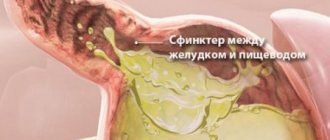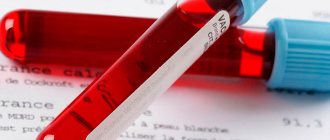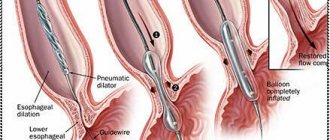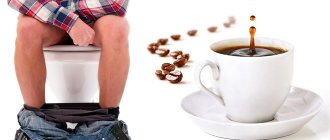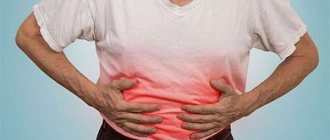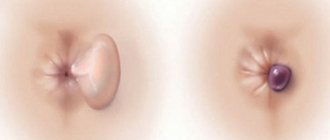Author of the article: Tironova Inna Igorevna
Gastroenterologist, therapist
15 years of experience
Professional skills: Colon hydrotherapy, treatment of gastrointestinal diseases
The inflammatory process occurring in the appendix of the cecum (appendix) has many characteristic signs. They allow you to promptly identify a dangerous pathology and begin treatment. First of all, a person is worried about acute pain in the peri-umbilical area of the abdomen on the right, an increase in body temperature, nausea and dizziness. Diarrhea with appendicitis is a common occurrence. Sometimes it occurs after surgery and is regarded as a postoperative complication.
What is the appendix and why does it become inflamed?
The appendix is a hollow organ of the gastrointestinal tract (gastrointestinal tract) and is an appendage of the cecum. Visually, it is a small worm-shaped process, about 20 mm in diameter and 90 mm in length. Locally refers to the lower intestine - the colon. The appendix is located in the lower right zone of the iliac region, covering the abdominal cavity from the lower ribs to the ilium. What else is on the lower right for men?
- Terminal part of the ileum . The organ is involved in the breakdown of nutrients and nutrients. It ends with the ileocecal valve, which separates the small and large intestines.
- Ascending colon.
- Caecum , from the mid-posterior surface of which the appendage extends. The cecum absorbs a liquid base of chyme (semi-digested food coming from the stomach).
The location of the appendix is marked in red on the diagram.
The causes of inflammation are associated with blocking the lumen of the appendix:
- fecal stones or undigested food;
- overgrown appendage tissue or neoplasm (tumor);
- bacteria and parasites.
Appendicitis may be a consequence of an anatomical abnormality (kinking of the appendage) or weak peristalsis.
Diarrhea after appendix removal
Quite often, patients experience loose stools after removal of the appendix, during the rehabilitation period, when the operation has already been performed. It is associated with:
- A forced gentle diet, in which food must be consumed in liquid, jelly-like form.
- Allergy to medications used.
- Disturbance of the microflora of the intestinal environment - dysbacteriosis.
- Intensive therapy using antimicrobial drugs.
- Parasitic infestations.
- Weakened immune system.
Feces acquire a liquid consistency under the influence of antibacterial drugs necessary for successful postoperative recovery. At this time, elements of undigested food are found in the stool.
Against the backdrop of stress, recent surgery and inflammation, chronic diseases affecting the digestive system are exacerbated. It is because of them that patients experience diarrhea after appendicitis. To clarify the situation and find out the cause of the malaise, it is necessary to undergo tests, do an ultrasound of the abdominal organs, and undergo an endoscopy.
Important! If you notice bloody discharge in your stool, you should consult a doctor.
What are the forms of appendicitis?
The inflammatory process occurs in an acute, complicated, and less often chronic form. The intensity of symptoms is determined by the clinical and morphological classification of the disease.
Morphology of acute appendicitis:
- catarrhal – damage to the epithelial cells of the mucous layer;
- phlegmonous - inflammation of the mucous and submucosal layers, accumulation of pus;
- gangrenous - suppuration and necrosis of the appendage;
- perforated - perforation (violation of integrity) of the walls, with the release of pus into the abdominal space.
On average, in the body of an adult, inflammation of the appendix develops within 2 days, followed by death of the neural endings of the peritoneum and other complications.
Signs of acute appendicitis in adults and children are identical, but appear at different speeds. In childhood, symptoms develop more rapidly, and the risk of purulent complications is higher than in adults.
Morphology of complications:
- peritonitis - purulent inflammation of the abdominal cavity;
- abscess - accumulation of purulent masses in the peritoneum;
- appendiceal infiltrate - a tumor spreading to the cecum, appendix and visceral fold of the peritoneum;
- pylephlebitis – purulent inflammation of the hepatic portal vein;
- empyema of the appendix - blockage of the appendix filled with purulent contents (without effusion into the abdominal cavity).
Classification of chronic inflammatory process:
- primary;
- recurrent (repeated).
In contrast to the acute and complicated condition, the symptoms of chronic appendicitis in men are mild. The disease is characterized by a wave-like course and is diagnosed in the acute phase.
Treatment
At the first signs of diarrhea with severe pain in the appendix area, nausea, you should consult a specialist. When appendicitis is diagnosed, surgery is prescribed. Stopping the inflammatory process allows you to cope with diarrhea.
If a patient has diarrhea after laparoscopy on the caecum, medications are prescribed to help cope with diarrhea and improve the patient’s general condition.
In case of severe dehydration, rehydration solutions are prescribed intravenously or orally to help replenish the deficiency of fluid, salts and electrolytes.
To remove toxins and prevent dehydration, sorbents are prescribed, among which the most effective are: Smecta, Polysorb, Enterosgel, Activated carbon. The latter drug is not used in children under 3 years of age. The dosage is calculated based on the patient’s body weight.
To restore intestinal microflora and prevent dysbiosis, probiotics are prescribed, which contain bacteria beneficial to the gastrointestinal tract: Linex, Bifidumbacterin, Hilak Forte, Acipol.
If the digestion process of food is disrupted, the patient is prescribed enzymes: Pancreatin, Mezim, Creon. The drugs are indicated for the treatment of enzyme deficiency in adults and children over 3 years of age.
To reduce intestinal motility, on the recommendation of a doctor, drugs with loperamide (Loperamide, Diara, Imodium) can be used. Medicines act quickly, reduce the speed of movement of feces through the intestines and increase the tone of the anus, which reduces the number of urges to defecate.
How does an attack of acute appendicitis begin?
How does appendicitis hurt: the first sign is acute pain (usually in the early morning hours or at night). In the initial period, pain is concentrated in the epigastrium and near the navel, then shifts to the side. Which side hurts with appendicitis? With a typical descending location of the appendage, as the attack progresses, the pain is concentrated in the iliac zone, on the right.
In addition to abdominal pain, the first signs of appendicitis in men, women and children include:
- heaviness in the epigastric region and nausea;
- low-grade fever (37-38℃);
- Widmer's sign is a difference of 1℃ between axillary (axillary) temperature and rectal temperature (in the rectum).
With increasing pain, hyperthermia increases to febrile values (38-39℃).
Symptoms of appendicitis: diarrhea
Patients often ask: can there be diarrhea with appendicitis? Acute appendicitis is manifested by pain in the lower abdomen on the right. The pain syndrome is caused by inflammation of the rudiment.
At the beginning of the disease, pain migrates without having an exact localization. First, the pain is determined in the epigastric or periumbilical region, and then moves down the abdomen on the right.
Pain migrating from the center of the abdomen to the lower right side is a sign of appendicitis
In addition to pain, patients exhibit signs of dyspepsia:
- constipation – caused by atony (intestinal paralysis due to pain and inflammation);
- gases with appendicitis - provoked by the lack of peristalsis, accumulation of feces;
- appendicitis with vomiting and diarrhea is accompanied by single vomiting and loose stools 1-2 times.
- appendicitis without vomiting and diarrhea - manifested by severe pain.
Dyspeptic symptoms are possible at the beginning of the development of the disease, which complicates diagnosis.
How does an inflamed appendix hurt?
The patient assumes a forced fetal position, with emphasis on the right side. The painful symptom of inflammation during appendicitis in men radiates to the pubic and genital area, in women – to the internal genital organs (ovaries, uterus).
A shift of pain to the right or Kocher's symptom develops after 2-4 hours. The attack itself lasts from 2 hours to 2 days. During this time, a person must receive medical care, otherwise it will not be possible to avoid purulent complications of the disease.
Pain with appendicitis in men spreads to adjacent organs. The process is reciprocal, that is, with intestinal pathologies (ileitis, colitis, Crohn's disease), pain radiates to the appendix.
The nature and location of pain may depend on the position of the appendix in the gastrointestinal tract. What hurts, what symptoms of appendicitis accompany the atypical location of the appendix?
Peculiarities:
| Anatomical position of the appendix | Pain zone |
| posterior (retrocecal) | rectum, anus |
| anterior (ventral) | lower back, kidneys |
| ascending (subhepatic) | right hypochondrium |
With an atypical location of the appendix in men, the symptoms are similar to those of:
- nephrolithiasis (kidney stone disease);
- alcoholic liver damage;
- prostatitis and prostate hyperplasia;
- cholelithiasis (cholelithiasis);
- exacerbations of stomach ulcers and chronic gastritis.
Specific symptoms and pain with appendicitis in men:
- sharp pain in the right testicle when pulling the scrotum by the base;
- raising the right testicle upward during palpation of the abdomen on the right is Britten’s symptom.
The testicle takes its correct anatomical position after treatment of appendicitis.
Associated symptoms of inflammation with appendicitis:
- reflex release of vomit;
- repeated diarrhea – when the colon is included in the pathological process;
- obstipation (constipation) – with involvement of the peritoneum;
- whitish or gray coating on the tongue;
- heart rate >100 beats/minute due to decreased blood pressure;
- increased formation of gases in the intestines;
- pale facial skin;
- pollakiuria (frequent emptying of the bladder).
The symptoms of chronic appendicitis in men are similar to acute manifestations, but are less intense and manifest only during the relapse period.
Causes of diarrhea with appendicitis
Diarrhea due to appendicitis is extremely rare and often leads to incorrect diagnosis. Inflammatory pathology is accompanied by constipation or rare loose stools no more than 2 times, as a rule, until the formation of a persistent clinical picture characteristic of appendicitis. Diarrhea in the acute period of appendicitis is:
- response to the inflammatory process and irritation of the peritoneum;
- the result of impaired absorption of fluid in the intestine;
- addition of infection;
- disruption of the natural environment of the intestine;
- relapse of chronic diseases against the background of decreased immunity due to appendicitis.
How is appendicitis diagnosed in men?
Diagnosis of acute appendicitis includes:
- physical examination is the main diagnostic basis;
- CCA (general clinical analysis) of blood
- abdominal ultrasound.
In emergency cases, ultrasound examinations will be cancelled.
A blood test can determine whether there is appendicitis or not.
How to check symptoms of appendicitis in men? For differentiated diagnosis, the author's techniques of palpation of the abdomen are used, provoking sharp pain. An incomplete list of symptoms of appendicitis according to the authors includes:
- Shchetkin-Blumberg . Slow deep pressure on the wall of the peritoneum, with a sharp withdrawal of the hand.
- Aaron . Compression of the lower abdomen.
- Bartomier-Mikhelson . Palpation of the cecum with the patient in the left lateral position.
- Mendel . Percussion (tapping) of the anterior abdominal wall.
- Basler . Palpation of the abdomen from the umbilical region upward.
- Wachenheim-Reder . Rectal palpation.
- Dolinova . Forced retraction of the abdomen by the patient.
- Ikramova . Compression of the central artery in the right leg.
- Cope . Flexion-extension of the right leg while lying on the left side.
After a physical examination, capillary blood is drawn (from a finger). Clinical indicators of the inflammatory process are leukocytosis > 18 (*10^9/l), ESR >20 mm/h.
How is acute appendicitis treated?
There is no conservative treatment for acute appendicitis. The surgical operation to remove the inflamed appendix is called appendectomy. Intervention in the abdominal cavity is performed in two ways:
- traditional (open) laparotomy through incision of the anterior wall of the peritoneum;
- laparoscopy - through small incisions using trocars (special surgical instruments) and a laparoscope (endoscope with a video camera and lighting system).
The choice of technique depends on the complexity of the case, personal contraindications, hospital equipment and the qualifications of the surgeon.
Laparotomy for appendicitis
Traditional appendectomy surgery is performed under general anesthesia. It is practiced for appendicitis complicated by purulent processes (peritonitis, pylephlebitis, abscess, gangrenous and perforative inflammation).
Inflammation of appendicitis can only be treated surgically
The duration of the surgical intervention is determined by the complexity of the particular case (from 1.5 to 2.5 hours). In the postoperative period, antibacterial therapy is prescribed to prevent bacterial infections. Inpatient treatment takes from one to two weeks. After dissection of the abdominal wall, a scar of 10 to 14 cm remains. In budgetary medical institutions, the operation is performed free of charge.
Laparoscopy for appendicitis
Laparoscopic appendectomy is performed for acute and chronic appendicitis. The doctor makes three tiny incisions in the peritoneal wall to insert the laparoscope and trocars. The process is excised under the control of a video camera. A visual image of the internal abdominal space is transmitted to the monitor.
The average duration of the operation is 40-45 minutes. Hospital stay is limited to 3-4 days. After tissue fusion, three scars remain, measuring from 1 to 1.5 cm. Laparoscopic surgery:
- minimizes the risk of adhesions and postoperative complications;
- preserves body aesthetics;
- shortens the rehabilitation period.
The cost of laparoscopy for appendicitis in paid clinics ranges from 2 to 8 thousand rubles.
How is post-operative recovery going?
Home rehabilitation takes from 1.5 to 3.5 months, depending on the method of surgery, complications, and internal reserves of the body. Medical recommendations after appendectomy include:
- sexual rest (at least one week);
- refusal of sports activities and limitation of everyday physical activity (including heavy lifting, prolonged vertical position of the body).
- changing eating habits and diet.
Postoperative dietary therapy is compiled in accordance with therapeutic nutrition developed by Professor M. Pevzner. The diet is expanded sequentially so as not to overload the injured digestive system. Consistently changing the diet day by day after removal of appendicitis by laparoscopy ensures free gastrointestinal motility and promotes healing of the damaged area of the intestine.
Brief menu for days after appendicitis
- What is allowed for patients on the first day? Nothing. Fasting is indicated for 24 hours after surgery.
- Where to start? On day 1, “Table No. 0A” is prescribed, including a weak rosehip decoction, unsweetened tea, liquid jelly, chicken broth (the skin must be removed from the bird)
- What can you eat after appendicitis surgery on day 2? The second day is “Table No. 0B”. Liquid oatmeal porridge , low-fat cottage cheese (pre-blended in a blender), and 2% natural yogurt .
- What can you eat after appendicitis on day 3? On the third and fourth days, “Table No. 0B” is preserved, with additions in the form of soft-boiled eggs , steam omelet (or cooked in the microwave), and pureed vegetable soups .
- From days 5 to 7, “Table No. 0B” is shown. The diet includes baked dishes made from cottage cheese , stewed vegetables , steamed dishes made from minced chicken (turkey) meat, and low-fat fermented milk drinks .
- From 8 to 14 days after appendicitis, the patient moves to “Table No. 1”. The menu includes pasta , unsalted cheeses (ricotta, mozzarella giornata, tofu), unleavened pastries , mashed potatoes , berries and soft fruits .
- From the 15th day until the end of the rehabilitation period, it is recommended to adhere to the “Table No. 5” diet, used in the treatment of gastroenterological and hepatic pathologies.
Prevention
To minimize the development of diarrhea in children and adults after removal of the appendix, it is necessary to follow all the recommendations of the general practitioner. The patient's diet should include:
- Low-fat chicken broth.
- Boiled rice.
- Potato and vegetable puree.
- Boiled lean meat.
- Low-fat, steamed fish.
- Fermented milk products with a low fat content (for example, kefir).
It is important to maintain plenty of fluids, avoid eating fresh vegetables and fruits, and avoid eating spicy and fatty foods. The patient is supposed to rest for a sufficient amount of time and avoid physical activity. Eating is prohibited for the first 12 hours after surgery. Within a day you can get up, eat broth, drink unsweetened tea.
( 1 ratings, average: 5.00 out of 5)
Results
Appendicitis usually occurs acutely, with the risk of purulent complications in the abdominal cavity. Characteristic symptoms:
- sharp pain in the right iliac region;
- nausea, stool upset, vomiting;
- hyperthermia;
Specific signs of appendicitis in men in a full description of symptoms are:
- radiating pain in the pubis and penis;
- elevation of the right testicle and its pain when pulling the scrotum by the base.
Appendicitis can only be treated surgically.
The inflamed appendix is removed during laparotomy or laparoscopic surgery. [Total: 3 Average: 5/5]
Could diarrhea be a sign of appendicitis?
Primary signs of inflammation of the appendicular process:
- pain;
- elevated temperature;
- leukocytosis;
- urge to defecate;
- diarrhea;
- vomiting without relief.
It is important to promptly contact a medical facility for diagnosis and treatment of appendicitis. Often the patient mistakes the symptoms for food poisoning, exacerbation of gastrointestinal diseases, or symptoms caused by stress factors, and does not seek medical attention. This increases the risk of disease complications and the threat of death.
A harbinger of appendicitis is diarrhea up to 2-3 times, which is accompanied by increased pain and tension in the abdominal muscles. Isolated events of stool liquefaction are not taken as a diagnostic indicator.
The symptom develops more often in children than in adults, which is due to the anatomical features of the structure of the body. With an atypical location of the appendicular process - between the loops of the small intestine - diarrhea in 90% of cases will accompany the development of appendicitis.

